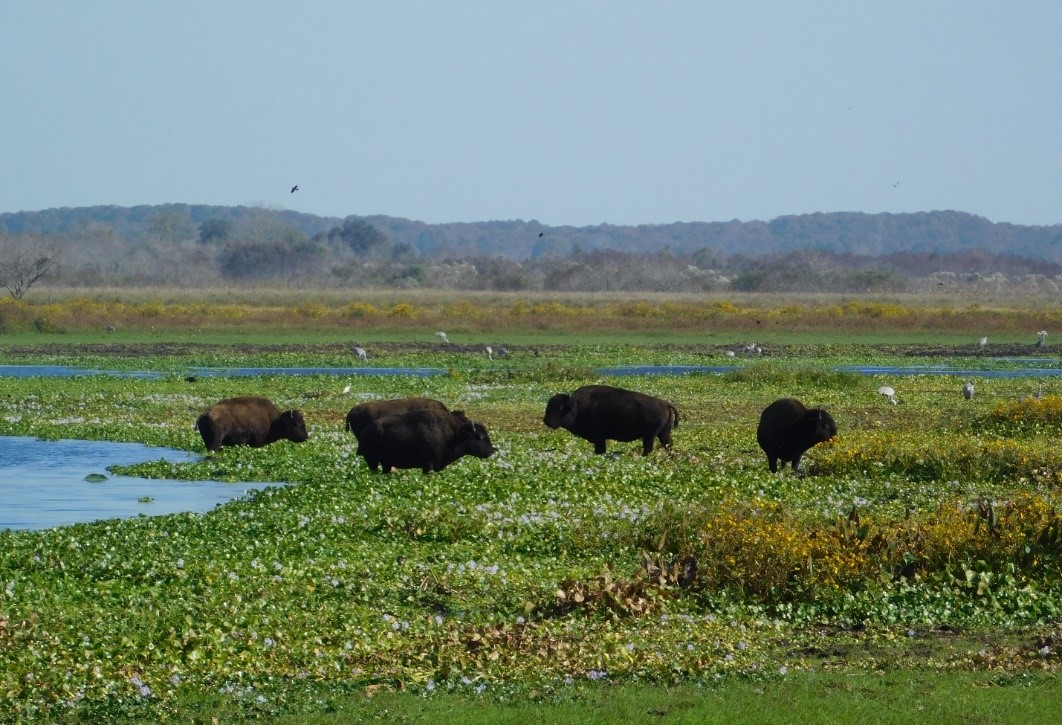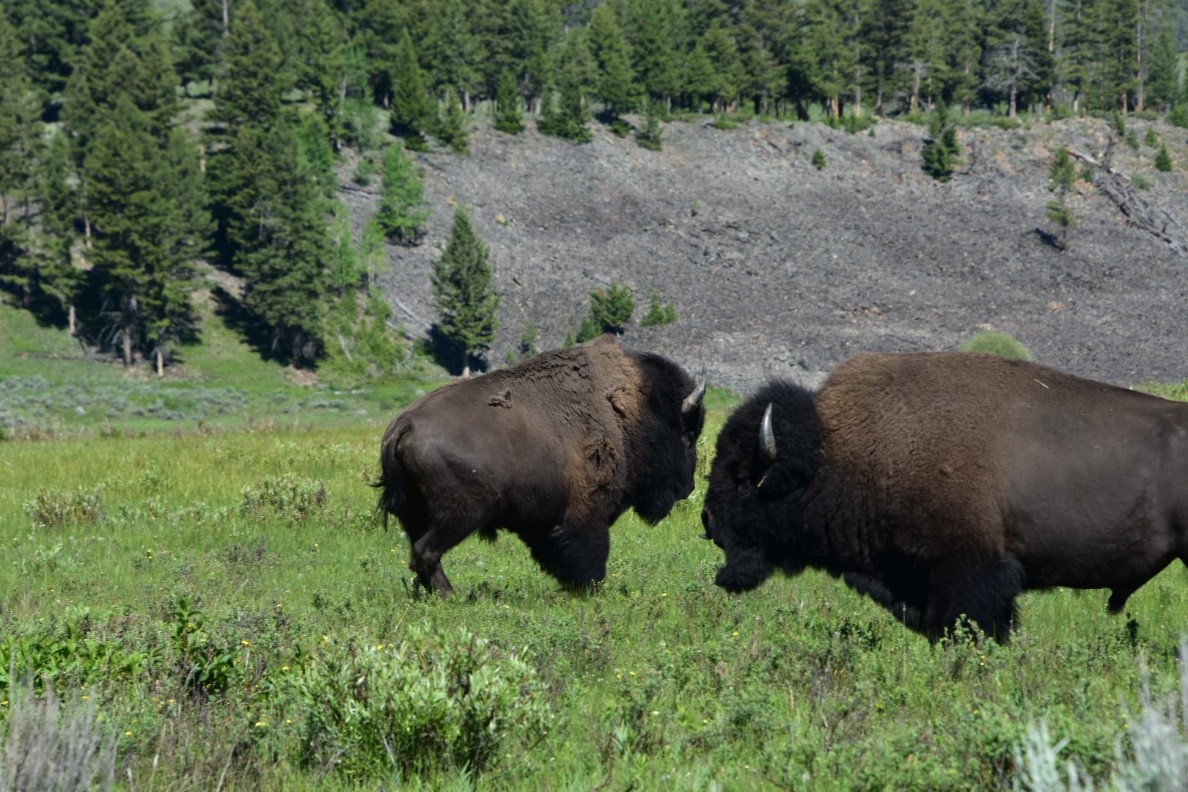Article begins
Despite renewed enthusiasm for returning bison to the prairie, most animals are raised for commercial purposes. It might take some surprising coalitions to increase conservation herds and bring back bison to our shared landscape.
With the passage of the National Bison Legacy Act (NBLA) on April 28, 2016, the bison was rendered a symbol of “unity, resilience, and healthy landscapes and communities” and selected as the United States’ national mammal. Something extremely rare occurred when senators and representatives of both parties came together to unanimously pass this act. Five months after its passage, in the Huffington Post article “Bison Have Been Bringing Americans Together for Centuries,” John F. Cavelli, vice president for international policy at the Wildlife Conservation Society, wrote how bison make finding common ground possible. For many, the NBLA provided the language to make such a claim: it identified bison as a historical symbol of the United States, it acknowledged the bison’s long ties to the economic and spiritual lives of many American Indian tribes, it recognized how more than 60 tribes participate in the Intertribal Buffalo Council and that numerous tribal members are involved in bison restoration on tribal land, and it accepted the important role bison play in maintaining the integrity of ecosystems. While the act made the bison our national mammal, it did not change any existing federal regulation or policy regarding the animal; it merely recognized that the shaggy bison with its red dog calves was woven into our cultural identity.

Image description: There are five bison standing adjacent to a pool of water in a wet marshy area and grazing on marsh grasses as birds that include egrets, herons, sandhill cranes, and a possible wood stork are eating and flying around them. The background includes green wetland vegetation, trees, and a blue sky.
Caption: Bison grazing in Paynes Prairie State Park in Florida. Barbara Jones
Place names that stretch from Buffalo, New York, to Buffalo, Wyoming, the bison’s presence on state quarters or flags, and also the World’s Largest Buffalo Monument sculpture in North Dakota suggest a powerful bison imagery exists within the American consciousness. By the time the first European settlers and hunters entered the western grasslands there were so many bison that their presence defined the landscape. Their numbers were so great they naturally expanded eastward with documented evidence of bison as far southeast as central Florida. In the eighteenth century, William Bartram, a renowned Florida explorer, wrote in his travel journal, “The buffalo…once so numerous is not at this day to be seen in this part of the country.” Yet today, hundreds of years after the last bison was spotted in Florida, as part of the Real Florida initiative by the Florida Park Service, Paynes Prairie State Park near Gainesville has become the home to 50 genetically pure bison. According to Donald Forgione, the park’s manager, of the horses, alligators, and bison in the park, the bison are the “icing on the cake.” Although the bison are constrained behind a fence, they roam across 22,000 acres with no human contact.
For the grassland ecosystems of the West, the bison story is different and sadly more defining of a shared American story. The grasslands that once supported millions of bison became home to a mere handful. Those that remained found refuge in places like Yellowstone National Park (YNP) or Charles Goodnight’s ranch in Texas. The bison that had played a critical role in Native American survival and identity were shot by Europeans seeking their fortune or food, and were almost extirpated to make room for the railroad and an influx of settlers. The prairie with its unique ecosystem that benefitted from the large nomadic herds of bison and their stamping, wallowing, and grazing quickly became a land of farmers and plows. A market economy that didn’t appreciate the finite nature of a species and a food production system that relied on the plow had cultural, ecological, and economic consequences still felt today.
From this travesty, a conservation ethic rooted in saving the bison was born. In 1905, there were 100 bison in public herds. The majority of them were in YNP, with five on live display at the Smithsonian in Washington, DC. In that same year, to save bison from extinction and raise public awareness about these unique animals, private citizens as well as William Hornaday, the first director of New York Zoological Park (Bronx Zoo), and Theodore Roosevelt founded the American Bison Society (ABS). A few years later, the ABS moved to establish a free-ranging herd. In 1907, Hornaday, who had been raising genetically pure bison at the zoo, sent 15 to Wichita National Forest Preserve in Oklahoma and, in 1913, 13 to Wind Cave National Game Reserve. Today, Wind Cave National Park in South Dakota and Wichita Mountain in Oklahoma maintain parts of our national herd. By 1910, the ABS census estimated there were 1,076 bison in Canada and another 1,032 in the United States with an additional 151 in public herds. To accommodate the increasing number of bison, President Roosevelt created the National Bison Range on land taken from the Flathead Indian Reservation. In 1935, with total bison numbers in the United States at around 22,000, the ABS voted itself out of existence. A population that once numbered in the tens of millions was seen as recovered with only 22,000 animals.

Image description: A stuffed bison is displayed in a gift shop. In front of it, clothes are for sale on a rack, and behind it, a bookcase contains books for sale.
Caption: A stuffed bison at the Jackson Hole Historical Society and Museum. Jackson, Wyoming. Barbara Jones
According to Shana Drimal of the Greater Yellowstone Coalition, bison are “the charismatic face of the plains,” and while evidence from her work suggests they are “more popular than any other megafauna,” today, other than those found in YNP, most bison in the United States are considered to be livestock. As captive herds subject to anthropogenic forces, they are less likely to compete with other grazers, interact with wild predators, or influence an ecosystem through their actions. Because ranchers fear bison will transmit brucellosis to their cattle, bison cannot move freely over the landscape like elk or deer can. Although elk are also carriers of the disease, it is only when bison leave YNP to find food that, to one bison activist, they can be “slaughtered” by park officials or bison hunters. He described how, when bison leave Yellowstone, they travel the “final four miles [of their traditional migration route out] through Roosevelt Arch [YNP’s north entrance] to Beattie Gulch” where they meet their end “trapped” for a “canned hunt” or, if they are lucky, are quarantined for transport to tribal lands as livestock.
The Intertribal Buffalo Council was established in 1992 to transfer bison from national park lands to tribal lands. It consists of 69 tribes in 19 states that maintain a collective herd of over 20,000 bison spread across reservation lands that total 32 million acres. Of that land, one million acres are home to restored bison herds that include highly managed small herds to free-range large herds of a thousand or more animals. Currently, the Fort Peck Assiniboine and Sioux Tribes in Montana maintain both commercial and conservation or cultural herds. To initially establish these conservation or cultural herds, bison needed to be transferred from YNP to their tribal lands, but because of rancher opposition to the transfer tribal groups spent years in legal battles with the state of Montana. Eventually, the Fort Peck Tribes won their case, and today bison are returning to more and more tribal lands.
Renewed enthusiasm for returning bison to the prairie reflects a general change in our relationship with wild nature. With fears over habitat decline, climate change (the prairie is exceptional at sequestering carbon), and species extinctions, listing the bison as “ecologically extinct” has encouraged a new wave of bison conservation enthusiasts. It also led, in 2006, to the reestablishment of the ABS by the Wildlife Conservation Society. In Montana, this enthusiasm is tempered by ranchers concerned over the American Prairie Reserve’s (APR), a nonprofit formed to manage Montana’s unique northern grassland ecosystem, goal of buying and then returning ranchland to native grassland habitat. Yet the ranchers’ usual persuasiveness is being met by tribal groups who by bringing bison back have made themselves a more visible and potent force in the West. As part of a larger reconciliation process, the National Bison Range land taken by the federal government was recently returned to the Confederated Salish and Kootenai Tribes. This call to action has highlighted the role disparate groups can play in restoring bison to landscapes from the Intermountain West to the depopulated central plains.

Image description: Two large male bison are in fighting position standing in a lush green valley. The bison had been fighting but have now backed off and are standing still. Behind the bison is a rise that has a gravel slide with evergreen trees.
Caption: Two male bison facing off in Yellowstone National Park, Wyoming. Barbara Jones
As the NBLA with its bipartisan support suggests, returning bison to the prairie has the potential to satisfy a broad constituency. In “Make Way for Buffalo,” journalist Nicholas Kristof wrote in 2003 that “Th[e] forlorn farm town [of] Rawson [a now unincorporated farm community in North Dakota], population 6—is a fine place to contemplate the boldest idea in America today: rescuing the rural Great Plains by returning much of it to a vast ‘Buffalo Commons.’” Using bison as the attraction, rural areas across the prairie could become tourist destinations bringing much needed economic renewal to vanishing communities. In the September 2020 issue of the National Review, the journalist Santi Ruiz wrote how the online Right “megafauna nationalists” also dream of rewilding America with bison. To Ruiz, a partnership that includes support from “unexpected places” could help build a powerful coalition pushing for the bison’s return to large swaths of public land. Western tribal groups, bison conservationists, East Coast New York Times readers, and online Right “megafauna nationalists” (who he believes have a “visceral hunger for moonshot projects”) working together with affected communities might be just what Ruiz had in mind.
Yet for all this bison love there are still too few bison in conservation herds. Recent counts from APR estimate the number of bison in America today to be 360,000, yet less than ten percent of those bison or about 31,000 animals are in conservation herds. Most bison are raised for commercial purposes. As livestock, the bison’s wild megafauna essence is reduced to that of a non-native Hereford, while as wildlife, we really don’t know our cultural carrying capacity for bison freely moving across the plains. Although passing the NBLA was a critical step in redefining our relationship with this charismatic wildlife icon, returning bison to our shared landscape might take the unity of purpose forged through some unlikely American partnerships.
Barbara Jones is a professor of anthropology at Brookdale Community College. She is also the author of Wild Capital: Nature’s Economic and Ecological Wealth. Her current research focuses on reimagining nature’s “inconvenient species.”
Barbara Jones is the section contributing editor for the Society for Anthropology in Community Colleges.
Cite as: Jones, Barbara. 2021. “Unifying America One Bison at a Time.” Anthropology News website, March 26, 2021. DOI: 10.14506/AN.1607

